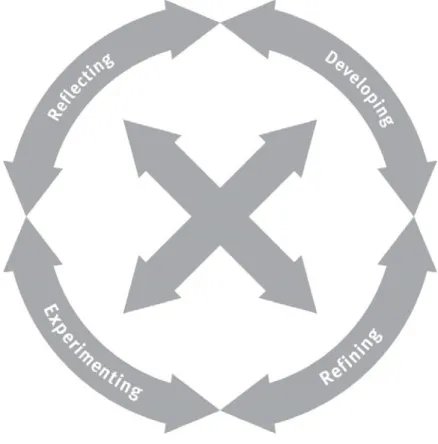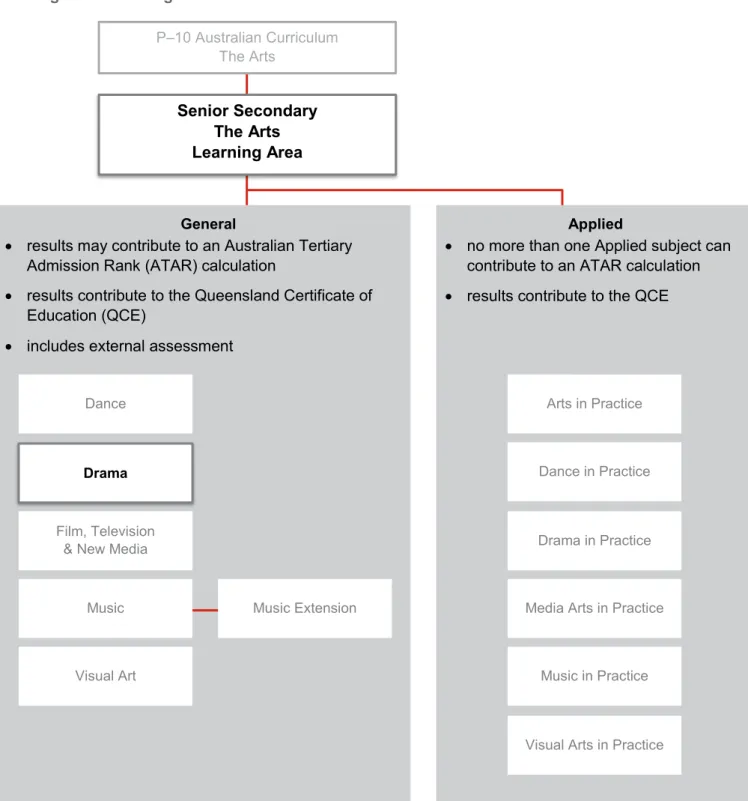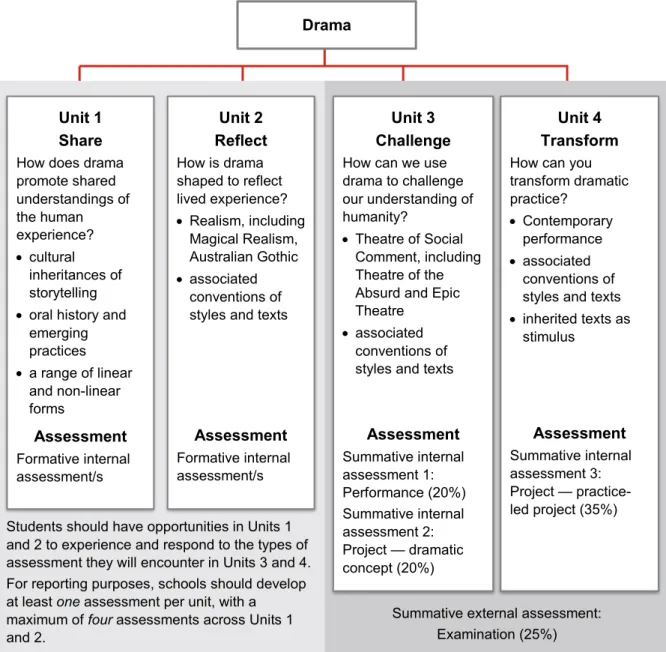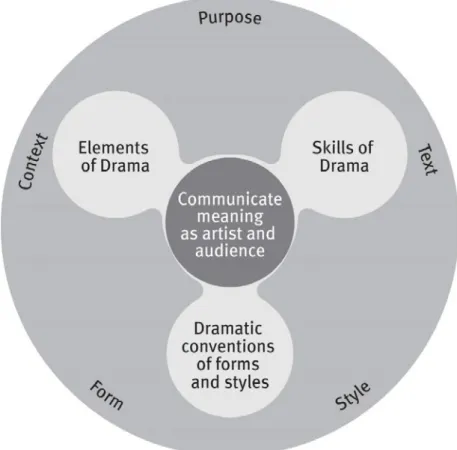Introduction
Rationale
A course of study in Drama establishes a basis for further education and employment across many fields, both within the arts and culture industry and beyond. The key ideas of making and responding identified in the P–10 Australian Curriculum: The Arts continue in senior syllabuses throughout the Arts learning area. Previous experience in any or all of the Arts subjects will give students an understanding of making and responding as learning and assessment in Drama.
Through making, students 'learn about and use knowledge, skills, techniques, processes, materials and technologies to explore art practices and make artworks that communicate ideas and intentions' (Australian Curriculum 2017). Drama is a general subject suitable for students interested in pathways out of school leading to tertiary studies, vocational training or work. A course in Drama can form a basis for further training and employment in the field of drama and into wider areas in creative industries and cultural institutions.
As more organizations value creativity and work-related diversity, Drama's processes and practices develop transferable 21st century skills essential to many areas of employment. Different pathways can include fields such as psychology, social work, counseling, law, journalism, and human relations.
Learning area structure
Course structure
Teaching and learning
- Syllabus objectives
- Underpinning factors
- Aboriginal perspectives and Torres Strait Islander perspectives
- Pedagogical and conceptual frameworks
- Subject matter
- Dramatic languages
When students use the dramatic languages, they use their knowledge and understanding of the elements of drama, skills of drama and conventions of forms and styles. When students manipulate dramatic language, they adapt and shape it to create dramatic action and meaning. They justify by providing examples or evidence of the use of dramatic language in the creation of dramatic action and meaning.
They evaluate the dramatic works of others and the dramatic action and meaning they have created. Purpose, context, and text work together to inform the creation of dramatic action and meaning. Purpose refers to the intent of the creator(s) or interpreters of the dramatic action and meaning.
Students understand, manage, manipulate, analyze and evaluate dramatic language when they react and make dramatic action and meaning. Drama skills are interrelated and support the knowledge and processes needed to create/make and respond to dramatic action and meaning.

Assessment — general information
Formative assessments — Units 1 and 2
Summative assessments — Units 3 and 4
Assessment evidence of student performance in each criterion is linked to a performance level descriptor, which describes the typical characteristics of student work. Where a student's response has characteristics of more than one performance level, a best-fit approach is used. Where a performance level has a range of two points, it must be decided whether the best fit is the higher or lower end of the range.
Schools and teachers must have strategies in place to ensure that work submitted for internal summative assessment is the student's own work.
Reporting standards
The student demonstrates by making and responding an understanding of dramatic language as he retrieves and understands information. The student applies analytical processes by: using reading skills to describe ideas; organize dramatic ideas to fit context or purpose; analyze dramatic action and meaning to explain elements of drama or conventions of selected form/style; and interpreting text to show an understanding of situation, role and relationship. The student uses knowledge of dramatic conventions to create action, describe dramatic elements and conventions in selected forms and styles, and make opinions or statements about choices regarding dramatic action and meaning.
The student applies analytical processes by reciting text, stating dramatic ideas, identifying elements of drama or conventions, and using terminology to identify dramatic action. The learner applies knowledge by using voice to deliver text, describe isolated elements or conventions, and make an opinion or statement about dramatic action. In Unit 1, students explore the importance of drama as a means of telling stories and sharing understandings of the human experience in a range of cultures, including those of Aboriginal and Torres Strait Islander peoples and/or those of the Asia-Pacific region.
They will engage with foundational content, skills and processes of drama to develop and share their unique artistic voice and develop an aesthetic awareness. Students engage in the skills of acting, critique and invention and work independently and as an ensemble to structure dramatic action and meaning.
Unit objectives
Students study this unit with the aim of celebrating, documenting, empowering and informing audiences through storytelling as a dramatic form. They manipulate and shape dramatic languages to explore a range of linear dramatic forms and non-linear dramatic forms through scripted and non-scripted texts. In this unit, students develop the knowledge, understanding and skills needed to create and respond to dramatic works that use a wide range of dramatic conventions to tell stories in linear and non-linear forms.
Area of study: How does drama promote shared understandings of
Assessment guidance
The unit introduces students to the dominant paradigm of drama that embraces notions of truth and authenticity in performance. Over the course of the unit, students explore the representative dramatic traditions of Realism and then explore more contemporary dramatic styles associated with the Realist style, such as Magic Realism, including Australian Gothic theatre. The unit is concerned with informing and challenging the public, understanding and empathizing with the truth of others.
In this unit, students develop the knowledge, understanding, and skills necessary to create and respond to dramatic works that strive to be authentic and truthful reflections of the human condition.
Unit objectives
Area of study: How is drama shaped to reflect lived experience?
Patricia Cornelius: Boy Overboard (The Play) (adapted from Morris Gleitzman's novel of the same name). Dorothy Hewett: Collected Plays — This Old Man Comes Home; Mrs. Porter and the Angel;. Andrew McGahan and Shaun Charles: The White Earth (adapted from Andrew McGahan's novel of the same name).
Eva Di Cesare and Sandra Eldridge: Thursdays Child (adapted from Sonya Hartnett's novel of the same name).
Assessment guidance
Unit description
Unit objectives
Area of study: How can we use drama to challenge our
Bertholt Brecht: Caucasian Chalk Circle; Mother Courage and Her Children; Man is equal to man; The Elephant Calf; Galileo; Good Lady of Szechuan; Fear and misery of the Third Reich; The irresistible rise of Arturo Ui; Baal.
Assessment
Summative internal assessment 1 (IA1): Performance (20%)
Preparation time: 9–12 hours (practice and presentation); this will involve class time and students' own time. Performance time: 3–5 minutes (all students must be actively involved on stage for a minimum of 3 minutes and no more than 5 minutes).
Summative internal assessment 2 (IA2): Project — dramatic concept
Length: Analysis and evaluation (400 words maximum) and my concept (800 words maximum), including digital recording of 10–12 images.
Summative external assessment (EA): Examination — extended
In Unit 4, students explore inherited theater traditions and key dramatic works of the past as a springboard for developing their own artistic statement. The unit involves students manipulating and shaping dramatic languages to transform text, purpose, context and meaning, drawing on the conventions and philosophies of contemporary performance. Students reimagine, adapt, and transform texts from inherited traditions into expressions of their emerging artistic voices that address the needs of 21st century audiences.
In this unit, students develop the knowledge, understanding and skills needed to create and respond to dramatic works that transform and challenge meaning and how stories can be performed.
Unit objectives
Area of study: How can you transform dramatic practice?
Assessment
Summative internal assessment 3 (IA3): Project — practice-led
Summative external assessment (EA): Examination — extended
Applied courses have no external assessment, but the result of the course can contribute to ATAR calculations. apply knowledge and understanding in response to a particular situation or circumstance; perform or use a procedure in a particular or given situation. assess the value, significance or status of something; evaluate or consider a text or paper. appreciate the worth or value of something recognize or pass judgment on it; fully understand; understand its full implications. suitably acceptable; appropriate or appropriate for a particular purpose, circumstance, context, etc. appropriation an extension or transformation of text and previous ideas to make them relevant to contemporary audiences. appropriate to the purpose or occasion; appropriate, appropriate field of study a department of, or a section within, a unit. argue giving reasons for or against something; challenge or discuss a problem or idea; to convince, prove or attempt to prove by giving reasons. aspect a particular part of a characteristic of something; a facet, phase, or part of a whole. assess measure, determine, evaluate, estimate or make a judgment about the value, quality, outcomes, results, size, significance, nature or magnitude of something. assessment purposeful and systematic collection of information about students. assessment tool a tool or device used to collect information about student performance. assessment objectives derived from the objectives of the unit and contextualized for the requirements of the assessment tool. see also “syllabus objectives”, “unit objectives”). In drama, an element of drama; characterized by variation and breaking patterns in dramatic action. Greek drama is often characterized by the inclusion of a chorus that underlined the play's ideas, provided points of view, and focused on issues of the play and the implications of the action; the chorus established the play's ethical system and took part in the action;.


